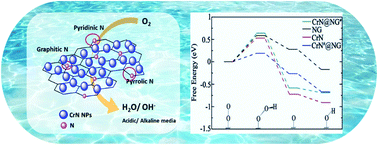Mechanistic study on nitrogen-doped graphitic carbon-reinforced chromium nitride as a durable electrocatalyst for oxygen reduction†
Abstract
Designing efficient catalysts for major energy conversion devices like fuel cells and metal–air batteries is of prime importance as the commercially used Pt/C catalyst impedes scalable use due to high cost, low stability, and methanol-intolerant behavior. Herein, we report a one-step method to synthesize phase-pure CrN nanoparticles (CrN NPs, ∼4 nm) anchored on N-doped graphitic carbon (CrN@NG) as an excellent Pt-free electrocatalyst to boost the oxygen reduction reaction (ORR) in alkaline and acidic media. The as-synthesized CrN@NG-900 competes with 20 wt% Pt/C with an E1/2 that is only 30 and 60 mV negative of Pt/C in alkaline and acidic media, respectively. Furthermore, the low-cost CrN@NG shows better long-term stability (no NP leaching or agglomeration) and methanol immunity that is desirable to replace Pt for applications in a real system. Density functional theory (DFT) calculations reveal a synergistic interaction between CrN and the NG support, which optimizes the free energy of the reaction intermediates and favors the ORR. The robust stability of the catalyst due to the NG support, better electron transfer, and greater electrochemically active sites augment the ORR activity in alkaline and acidic media.

- This article is part of the themed collection: Showcasing recent research in materials chemistry from IIT Bombay, IIT Indore and IISc


 Please wait while we load your content...
Please wait while we load your content...